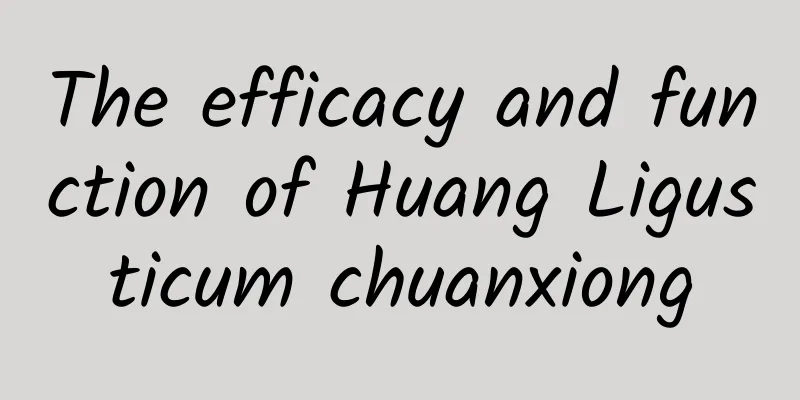The efficacy and function of Huang Ligusticum chuanxiong

|
For many Chinese people, traditional Chinese medicine is very trustworthy because it has a long history and few side effects. Rhizoma Dioscoreae is a common Chinese medicinal material, which has many benefits for human health. So how can we eat Rhizoma Dioscoreae? Let’s learn about it below. [Other names] Ligusticum chuanxiong, Ligusticum yunnanensis [Source] Medicinal material source: The root of the Umbelliferae plant. [Original form] Perennial herb, 40-70cm tall. The root is spindle-shaped, 5-12cm long, with fine annular lines on the surface, and is yellow-gray in color. The stem is branched near the base and 1/3 of the way up, has longitudinal stripes, and is smooth and hairless. The petiole of the basal leaf is 5-13cm long, with a membranous leaf sheath at the base. The leaf blade is pinnate-divided two to three times, with 4-6 pairs of pinnae. The final segment is broadly ovate, 5-15mm long, 4-12mm wide, sessile, with deeply lobed edges or irregular notched serrations, slightly thickened tooth margins, glabrous on both sides, and veins raised on the back. The compound umbel is terminal or lateral; the peduncle is up to 15 cm long; there are no or a few involucral bracts; there are 6-8 rays, spreading, 2-6 cm long; there are 7-9 involucral bracteoles, narrowly linear, about 5 mm long; the umbel has many florets; the calyx teeth are awl-shaped and acute; the petals are white, nearly round, with an inflexed ligule at the apex and one midrib; the stylopodium is conical, and the style is recurved outward. The double-hanging fruit is narrowly ovate, gradually narrowing upward, smooth, and the fruit ridges are filiform; the bilaterian fruit is semi-cylindrical, with a protrusion on the back, and the commissure is nearly straight. There are 2-3 oil tubes in each groove and 4 oil tubes on the commissure. [Habitat distribution] Ecological environment: Growing in hillside grasslands, sparse forests or rock crevices at an altitude of 2000-2500m. 【Nature and flavor】 Spicy; bitter; warm 【Functions and indications】 Releases wind; relieves pain; acts as a diuretic. Mainly used for colds, coughs, headaches, rheumatic pain, and edema caused by wind and water [Usage and Dosage] For oral use: decocted in water, 3-10g. 【Excerpt】 Chinese Materia Medica The above is an introduction to the Chinese medicinal material Rhizoma Ligusticum chuanxiong. For medicinal herbs that we don't understand, we should learn more about them so that we can make full use of them in our lives and not be at a loss. |
<<: The efficacy and function of Chinese honey locust
>>: Effects and functions of yellow alum
Recommend
This “sugar and oil mixture” makes you fatter than drinking oil. Why can’t you stop eating it once you start?
Crispy on the outside and tender on the inside, g...
In the competition for special drugs for COVID-19, which “players” stand out?
The new coronavirus pandemic is not over yet. In ...
Prunella Vulgaris plus brown sugar for thyroid
You may have heard of the medicine Prunella Vulga...
A lifelong passion for breeding! The wheat fields are rolling, but he is always absent
◎ Written by: Science and Technology Daily report...
The efficacy and function of fern
In fact, the occurrence of many human diseases is...
Parasitic effects of traditional Chinese medicine
What are the medicinal properties of parasites in...
The efficacy and function of golden burdock tea
It is detailed in the book: Burdock is warm in na...
Traditional Chinese medicine for astringency and muscle growth
Astringent and tissue-generating Chinese medicine...
What effect does sound have on photosynthesis in plant leaves?
As animals, it is not only us humans who are sens...
What are the effects of astragalus and red dates
In ancient times, people did not have the advance...
World Parkinson's Day | There are so many misunderstandings about this disease! Test yourself...
Today (April 11) is World Parkinson's Day. Pa...
Qitai Radio Telescope: Listening to the Universe in Silence
Produced by: Science Popularization China Author:...
A baby saber-toothed tiger from 30,000 years ago was discovered! It still had whiskers and claws
Produced by: Science Popularization China Author:...
Summer chrysanthemum can treat breast hyperplasia
Women's breasts are relatively important to w...
The efficacy and function of kudzu leaves
Kudzu leaves are something that many people are v...








![The efficacy and function of Isatis indigo leaf[picture]](/upload/images/67ca743d5fd4b.webp)
